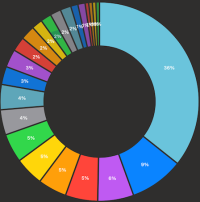ONE use for a zoom is "walking around, and unexpected shots". The RF100-300 clearly isn't intended as a casual walkabout lens, it's primarily designed for people who photograph sports and wildlife in low light conditions, and for whom a fixed focal length would be too restrictive.I could afford this lens if I could justify it. But, as much as I'd love to, I really kind of can't. Yes, it's considerably faster than my RF 100-500. Yes, it is considerably longer reach than my RF 70-200 2.8. Yes, it is more versatile than my EF 300 2.8. But is costs almost as much as all three of those put together (3 good copies on the used market), is almost as long as the 300 2.8 plus the 70-200 2.8 end-to-end (!), and, overall, is about as subtle as a train wreck. (And, I don't need to compensate for a micro-phallus).
A zoom is for walking around, and unexpected shots. (If you know what you're going to shoot, you take a prime). For walking around, this lens would make an elephant jealous. I just don't see myself walking around with it. In the forest and beach it'll get abused/damaged, and, in the city, I'll probably get mugged for it.(Although it might serve as a decent self-defense weapon). The market for this lens is small and totally niche- (1) indoor fast action, and, (2) people with a crap ton of Bitcoin. In today's world, that probably means it'll be a screaming success. But... I'll wait for a good used copy, for sure.
Wildlife and sports photographers typically work from a fixed position (e.g. a goal mouth, or bird hide), and will be using this lens with some kind of support - a monopod, tripod & gimbal, or a beanbag. The size and weight in these circumstances isn't particularly relevant.
If you are working from a fixed position, with e.g. a 300/2.8 or 500/4, what happens when a subject suddenly appears at a close distance? One option would be to have two cameras, one equipped with a short focal length lens, and swap over to that. But action, by definition, usually happens rapidly and unpredictably. It's considerably faster to zoom back, than to swap cameras.
In the hands of a poor photographer, a zoom is a lazy way to get close to a subject without walking. In the hands of a good photographer a zoom is a lens that considerably increases versatility and results in more images from each shoot.
Of course, it's fairly obvious that all of us would prefer lenses to be smaller, lighter and less expensive. So yes, this is a niche lens. But don't begrudge those professionals who need it, or those affluent hobbyists who can afford it, and are not bothered by the size or weight.
Last edited:
Upvote
0

